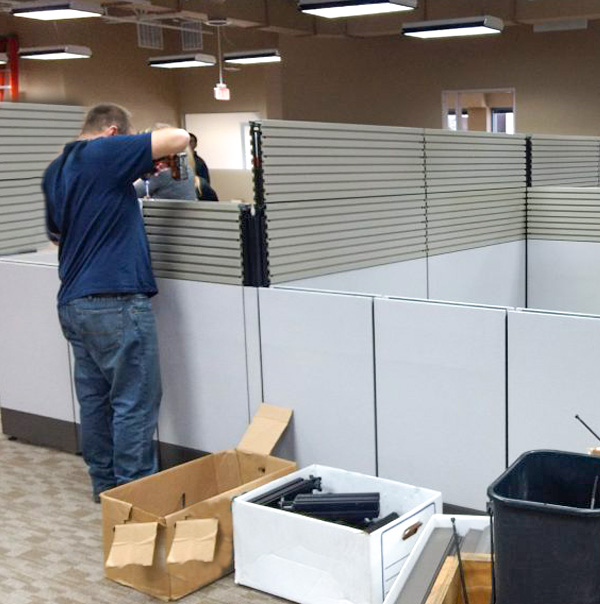Businesses have been evolving in recent times, and there’s no surprise that these businesses are making necessary changes to ensure that their profits are maximized, and resources are properly optimized. One of the many changes that businesses have been adapting to includes relocation. Relocation has become a common phenomenon for many businesses around the world. While a business may relocate for several different reasons, including better resource access, a better hiring pool, larger spaces available elsewhere, and more.
Regardless of why a business might want to relocate, the process continues to be daunting and extremely taxing for business owners and employees alike. A commercial relocation can cause several changes in business operations over a span of several months for it to be successful. So, in order to minimize disruption and losses, business owners and their executives need to be on their feet to ensure that the move is successful and smooth.
The only way a business can optimize its commercial move is by understanding the mechanics and applying different ways to ensure effectiveness. Even though most businesses might not deeply understand what a commercial relocation can entail and how it can affect your overall business, it’s always better to start by educating yourself.
If you’re about to relocate your business to a new location, you might want to keep reading the blog to understand how commercial relocation works, its effects on a business, and how to properly streamline the procedure.
Let’s begin!
What Does Commercial Relocation Entail?
Relocating a commercial establishment can be an exciting yet daunting task. Whether you’re expanding your business, seeking better opportunities, or simply upgrading to a new location, commercial relocation requires careful planning and execution. We will delve into the intricacies of commercial relocation, exploring its various aspects, challenges, and providing valuable insights to ensure a smooth transition for your business.
Planning Phase
- Establishing Objectives: Begin by identifying the reasons for your commercial relocation. Determine your goals, whether it’s to accommodate growth, access a new market, or improve operational efficiency.
- Budgeting:Assess your financial resources and set a realistic budget for the relocation process. Consider expenses such as lease agreements, moving services, equipment, and potential renovations.
- Creating a Timeline: Develop a detailed timeline that outlines key milestones, including lease negotiations, packing and moving, IT setup, and office setup at the new location. Allow ample time for each phase to minimize disruptions.
Location Selection
- Analyzing Market Potential: Conduct thorough research on potential relocation destinations, considering factors such as target market demographics, industry trends, competition, and economic stability.
- Accessibility and Infrastructure: Evaluate the accessibility of the new location for your employees, clients, and suppliers. Assess the availability of transportation networks, parking facilities, and other infrastructure necessary for your business operations.
- Cost Considerations:Compare the costs of rent, utilities, taxes, and other expenses in the new location with your current setup. Ensure that the financial implications of the move are viable and aligned with your business objectives.
Logistics and Coordination
- Professional Moving Services: Engage a reputable commercial moving company with expertise in handling office relocations. Collaborate closely with them to create a detailed inventory, develop a packing strategy, and plan the transportation of equipment and furniture.
- IT Infrastructure: Evaluate your current IT setup and determine if any upgrades or modifications are required at the new location. Ensure seamless connectivity by coordinating with your IT team or external service providers to minimize downtime during the transition.
- Communication and Employee Support: Establish clear channels of communication to keep your employees informed throughout the relocation process. Provide adequate support, including access to resources for packing, guidelines for personal belongings, and any necessary assistance during the move.
Transition and Post-Relocation
- Unpacking and Office Setup: Coordinate with the moving company to efficiently unpack and set up your office at the new location. Ensure that furniture, equipment, and supplies are placed strategically for optimal workflow and employee comfort.
- Employee Integration: Facilitate a smooth transition for your employees by providing orientation sessions, updated policies and procedures, and addressing any concerns or questions they may have.
- Testing and Optimization: Test all systems, equipment, and infrastructure at the new location to identify and address any potential issues. Optimize your workspace layout based on feedback from employees and their productivity requirements.
Effects of Commercial Relocation on a Business
Commercial relocation, while often undertaken to improve business prospects, can positively and negatively affect a company. Business owners and managers must understand these effects in order to mitigate challenges and capitalize on opportunities. Here, we explore the various impacts that office relocation can have on a business.
Disruption of Operations
Relocating a business inevitably disrupts daily operations. During the transition phase, there may be temporary downtime, production or service delivery interruptions, and challenges in maintaining normal workflow. This can result in decreased productivity, delays in fulfilling customer orders, and potential revenue loss. Proper planning and coordination are essential to minimize the impact on operations and mitigate these disruptions.
Cost Implications
Commercial relocation involves significant financial implications. There are expenses associated with lease negotiations, moving services, equipment transportation, renovations, IT infrastructure setup, and marketing efforts to inform clients and stakeholders about the new location. These costs can strain a company’s budget, especially if not adequately planned for. It is crucial to conduct a thorough cost analysis and develop a realistic budget to ensure the financial viability of the relocation.
Market Access and Expansion Opportunities
One of the primary reasons for commercial relocation is to access new markets or expand an existing customer base. Relocating to a strategic location with a larger target market or closer proximity to key clients can provide a business with new growth opportunities. It may open doors to increased sales, partnerships, and collaborations. Understanding the potential of the new market and adjusting marketing and sales strategies accordingly can help businesses capitalize on these opportunities.
Workforce Considerations
Relocation can have a significant impact on the workforce. Employees may face challenges such as long commute times, adjustments to new work environments, and potential changes in work-life balance. Communicating transparently with employees, addressing their concerns, and providing necessary support during the transition is crucial. Failure to manage workforce considerations effectively may lead to employee dissatisfaction, decreased morale, and potential loss of key talent.
Brand Identity and Customer Perception
Relocation can affect a company’s brand identity and customer perception. Changing the business’s physical address may require rebranding efforts, updating marketing materials, and ensuring consistent messaging across all communication channels. Existing customers may need to be informed about the relocation to avoid confusion. It is vital to effectively communicate the reasons for the move and the benefits it brings to maintain trust and loyalty among customers.
Infrastructure and Resource Optimization
Relocation offers an opportunity to optimize business infrastructure and resources. It allows companies to reassess their operational needs, upgrade equipment and technology, and implement improved processes. Relocation can also provide access to better facilities, enhanced logistical networks, and favorable cost structures. Careful planning during the relocation process can ensure that the new setup maximizes efficiency, productivity, and cost-effectiveness.
Competitive Advantage
By strategically relocating, a business may gain a competitive advantage over competitors. Accessing a new market, locating closer to key suppliers, or positioning the business in a more attractive commercial area can differentiate the company from its rivals. The new location may offer unique advantages, such as a supportive business ecosystem, access to specialized talent, or a favorable regulatory environment. Leveraging these factors can contribute to long-term success.
10 Ways to Simplify a Commercial Relocation
Commercial relocations can be complex and challenging, but with careful planning and execution, businesses can simplify the process and minimize disruptions. Here are several effective strategies to simplify a commercial relocation.
1. Start Planning Early
Begin the planning process as early as possible. The more time you have to prepare, the smoother the transition will be. Create a detailed timeline that outlines all the necessary tasks and milestones, such as lease negotiations, packing, moving, and office setup. Assign responsibilities to specific team members or departments to ensure clear accountability.
2. Conduct a Comprehensive Inventory
Before the move, conduct a thorough inventory of all equipment, furniture, and supplies. This will help you determine what needs to be moved, what can be sold or donated, and what needs to be replaced. An accurate inventory will streamline the packing and moving process and minimize the risk of items getting lost or misplaced.
3. Create a Detailed Floor Plan
Before moving into the new location, create a detailed floor plan that outlines the layout of the office space. Consider the needs and preferences of different departments and employees. Plan the placement of furniture, workstations, and common areas strategically to optimize workflow and promote collaboration. Sharing the floor plan with the moving company in advance will help them place items in the appropriate locations upon arrival.
4. Update IT Infrastructure
Relocating a business often involves transferring and setting up IT infrastructure and systems. Engage your IT department or external service providers early in the planning process to ensure a seamless transition. Evaluate your current IT requirements and setup and identify any necessary upgrades or modifications for the new location. Coordinate with internet service providers, telephone companies, and other vendors to ensure a smooth transfer of services.
5. Communicate with Employees
Open and transparent communication with employees is crucial throughout the relocation process. Keep your staff informed about the reasons for the move, the timeline, and any changes that may affect their roles or daily routines. Address their concerns and provide support during the transition. Consider holding regular meetings, sending out newsletters or updates, and setting up a dedicated communication channel to answer questions and provide guidance.
6. Delegate Responsibilities
Relocating a business is a team effort. Delegate specific responsibilities to trusted employees or departments to address all tasks adequately. This could include packing personal belongings, coordinating with vendors, updating customer records, or managing the logistics of the move. Clearly communicate expectations and provide the necessary resources and support to those involved.
7. Utilize Labeling and Organization Systems
Implement a labeling and organization system to streamline the unpacking and setup process. Label boxes clearly with the contents and the designated location in the new office. Color-coded labels or numbered systems can help ensure that items are placed in the correct areas without confusion. This will save time and effort during the unpacking process and facilitate a quicker return to normal operations.
8. Test and Optimize
Once everything is moved to the new location, thoroughly test all systems, equipment, and infrastructure to identify any issues or discrepancies. Conduct tests on phone lines, internet connections, security systems, and other critical components. Address any problems promptly to minimize downtime and ensure a smooth transition.
9. Provide Employee Support
Relocation can be stressful for employees, so it’s important to provide support throughout the process. Offer resources and assistance for packing personal belongings, provide guidance on the new location and commuting options, and address any concerns or questions they may have. Consider organizing an orientation session to familiarize employees with the new office layout and amenities.
10. Engage Professional Moving Services
Hiring professional commercial moving services can greatly simplify the relocation process. Look for experienced and reputable movers who specialize in commercial relocations. They will have the expertise and equipment necessary to securely handle office furniture, fragile equipment, and IT infrastructure. Collaborate closely with the movers to develop a packing and moving strategy that aligns with your business needs.
Hire Valley Relocation for Your Next Commercial Move!
Finding the right moving service for your commercial move can be a little frustrating since you need several requirements that need to be met. Luckily, Valley Relocation has been offering undisputed professional moving services to several different commercial clients across Silicon Valley, San Jose, Sacramento, and other parts of California.
Amongst the many services that they provide, Valley Relocation is known for their specialized transportation logistics, warehouse and storage services, their detailed facility services, and office relocation services.
For more information about our services, make sure you give us a call or check out our website.







